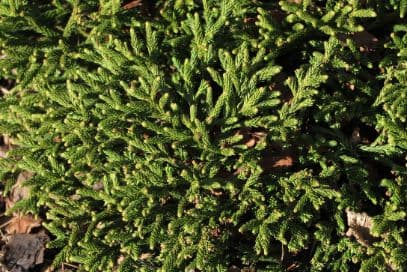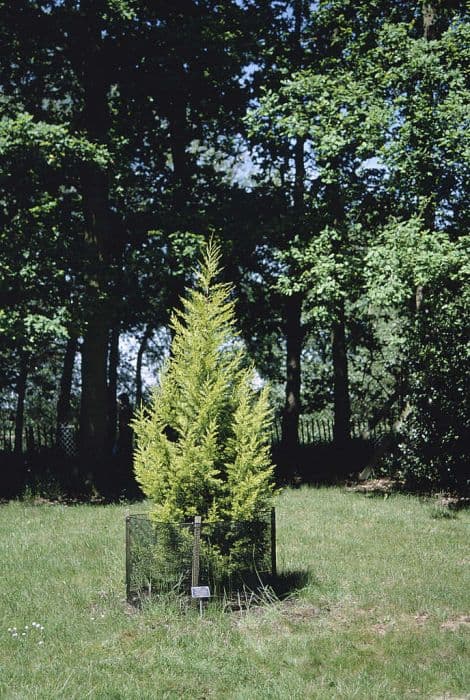Weeping Alaskan Cedar Xanthocyparis nootkatensis 'Pendula'

ABOUT
The plant, commonly known as the Weeping Alaskan Cedar, exhibits a very distinctive and elegant form, characterized by drooping branches that create a graceful, waterfall-like effect. Its foliage is comprised of flattened sprays that are a rich, dark green on the upper surface, with a hint of blue on the undersides, giving it a lush, two-toned appearance. The leaves are small and scale-like, closely pressed to the stems and overlapping each other, which adds to the overall fine-textured look of this plant. During the early years, the plant maintains a narrow, pyramid-like shape, but as it matures, it becomes more pendulous, with the branches cascading downward more dramatically. This weeping habit lends the Weeping Alaskan Cedar a soft, flowing aesthetic that can add a sense of movement and tranquility to landscape designs. In the spring, you may spot small cones that start off green and mature to a brown color as the seasons progress. These cones are fairly small, and they add to the decorative nature of the plant throughout the year. Overall, the Weeping Alaskan Cedar presents itself as a stately and attractive plant, with its long, weeping branches and textured leaves creating an elegant silhouette that can stand as a focal point in gardens or used as a backdrop for other plants.
About this plant
 Names
NamesFamily
Cupressaceae.
Synonyms
Weeping Alaskan Cedar, Weeping Nootka Cypress, Weeping Yellow-Cedar, Pendula Weeping Nootka.
Common names
Callitropsis nootkatensis 'Pendula', Cupressus nootkatensis 'Pendula', Chamaecyparis nootkatensis 'Pendula', Xanthocyparis nootkatensis 'Pendula'.
 Toxicity
ToxicityTo humans
The common name for Xanthocyparis nootkatensis 'Pendula' is Weeping Alaskan Cedar. This plant is not commonly known to be toxic to humans. If ingested, most people do not experience any adverse effects. However, as with any plant material, individual allergies or sensitivities can occur, so it is generally not advisable to consume parts of ornamental plants.
To pets
Weeping Alaskan Cedar is not commonly known to be toxic to pets either. It is not listed on the ASPCA list of toxic plants for dogs and cats, which suggests that it does not pose significant risks. As with humans, consumption of plant material by pets can sometimes lead to gastrointestinal upset or an allergic reaction, so it is best to prevent pets from ingesting this plant.
 Characteristics
CharacteristicsLife cycle
Perennials
Foliage type
Evergreen
Color of leaves
Green
Height
35 feet (10.67 meters)
Spread
15 feet (4.57 meters)
Plant type
Tree
Hardiness zones
4-8
Native area
North America
Benefits
 General Benefits
General Benefits- Landscape Aesthetics: The weeping Alaskan cedar provides a unique visual appeal with its graceful, pendulous branches and pyramidal shape, enhancing garden design and diversity.
- Habitat Support: By offering shelter and producing cones, it provides a habitat and food source for various wildlife such as birds and small mammals.
- Erosion Control: With its extensive root system, this tree can help stabilize soil, especially on slopes, reducing erosion.
- Privacy Screening: It can be used as a natural privacy screen due to its dense foliage, creating secluded garden areas or blocking unsightly views.
- Noise Reduction: The thick foliage can help dampen noise pollution, creating a more tranquil outdoor environment.
- Windbreak: When planted in rows or groups, the weeping Alaskan cedar can act as a windbreak, protecting other plants and reducing wind speed around homes.
- Shade Production: The weeping Alaskan cedar can provide shade in garden landscapes which can help lower local temperatures and create a cooler, comfortable outdoor living space.
- Year-round Interest: It offers year-round visual interest with evergreen foliage, which is especially valued in climates with long winters when other plants may be dormant.
 Medical Properties
Medical PropertiesThis plant is not used for medical purposes.
 Air-purifying Qualities
Air-purifying QualitiesThis plant is not specifically known for air purifying qualities.
 Other Uses
Other Uses- The Weeping Alaskan Cedar can be used as a sound barrier. When planted in a row, their dense foliage helps to dampen traffic and other unwanted noise from entering a quiet space.
- It serves as a unique bonsai specimen for enthusiasts looking to shape and cultivate this plant in miniature form due to its weeping branches.
- The wood of the Weeping Alaskan Cedar can be carved into small objects such as utensils, ornaments, or sculptures, owing to its fine grain and workability.
- With its tall and elegant form, it acts as a natural privacy screen for homes and gardens, providing a green curtain to shield from the eyes of neighbors.
- The tree's durable wood is sometimes used in the construction of outdoor structures, such as gazebos and pergolas, adding a rustic aesthetic.
- Gardeners use the tree's distinct form to create a focal point in landscape designs, drawing the eye with its pendulous branches.
- The wood's aromatic qualities make it suitable for creating small cedar sachets that can be placed in closets or drawers to impart a pleasant scent and deter moths.
- It provides unique nesting sites for birds. The dense foliage and weeping form offer shelter and a degree of protection for various bird species during nesting season.
- The Weeping Alaskan Cedar can be utilized in the art of topiary, with skilled pruning turning the natural droop of its foliage into creative designs.
- The tree's resistance to rot and decay makes it a good candidate for constructing outdoor fences that can endure harsh weather conditions.
Interesting Facts
 Feng Shui
Feng ShuiThe Weeping Alaskan Cedar is not used in Feng Shui practice.
 Zodiac Sign Compitability
Zodiac Sign CompitabilityThe Weeping Alaskan Cedar is not used in astrology practice.
 Plant Symbolism
Plant Symbolism- Eternity: Xanthocyparis nootkatensis 'Pendula', commonly known as Weeping Alaskan Cedar, is an evergreen tree, symbolizing eternal life due to its year-round foliage.
- Strength: Trees in general are often seen as symbols of strength and resilience, and the Weeping Alaskan Cedar, with its ability to withstand cold conditions, exemplifies these qualities.
- Solace: The weeping form of this tree may be perceived as offering solace and providing a visual expression of sympathy and sorrow, making it suitable for memorial gardens.
- Grace: The sweeping, pendulous branches of the tree suggest grace and elegance, representing the beauty and gentleness in nature.
- Adaptability: Because of its versatility in various landscapes and its adaptability to different environments, it is seen as a symbol of the ability to thrive under varying conditions.
- Peace: Green is a color commonly associated with peace and tranquility, and because the Weeping Alaskan Cedar maintains its green hue throughout the seasons, it evokes a sense of calm and serenity.
 Water
WaterThe Weeping Alaskan Cedar requires regular watering, especially during the first growing season to establish a deep root system. Once established, it's more drought tolerant. Water the tree deeply, then allow the soil to partially dry out before watering again. Generally, this means providing about 2 gallons of water per week, adjusting as necessary for rainfall, heat, and soil conditions. During periods of extreme heat or drought, increase the frequency of watering.
 Light
LightWeeping Alaskan Cedar thrives in full sun to partial shade. The ideal spot would provide at least six hours of direct sunlight per day, although it can tolerate light shade. Ensure that the plant is not shaded all day, as too little light can impede growth and reduce vigor.
 Temperature
TemperatureWeeping Alaskan Cedar can withstand a range of temperatures and is generally cold-hardy. The ideal temperature conditions for this tree fall between 20°F in the winter and 70°F in the summer, thriving in most temperate climates. It can survive extreme lows down to around -20°F but should be protected from harsh winter winds.
 Pruning
PruningWeeping Alaskan Cedar requires minimal pruning, mainly to maintain its shape and remove any dead or damaged branches. The best time to prune is late winter or early spring before new growth starts. Pruning should be done as needed to preserve the natural, drooping form of the branches and to ensure the health of the tree by removing problematic limbs.
 Cleaning
CleaningAs needed
 Soil
SoilThe Weeping Alaskan Cedar requires well-draining soil with a mix of loam and sand to mimic its native environment. Ideal pH is slightly acidic to neutral, ranging from 5.5 to 7.0. Incorporating organic matter such as compost can enhance soil fertility and structure for optimal growth.
 Repotting
RepottingThe Weeping Alaskan Cedar, being a large landscape tree, is not typically repotted. It is planted into the landscape and allowed to grow, only being moved if absolutely necessary, and with great care due to its large size and root system.
 Humidity & Misting
Humidity & MistingWeeping Alaskan Cedar prefers moderate to high humidity levels and can tolerate the humidity ranges commonly found in its natural outdoor environment. Ensure that it is not placed in extremely arid conditions to maintain its health.
 Suitable locations
Suitable locationsIndoor
Mostly unfeasible indoors, needs vast space, natural light.
Outdoor
Plant in well-draining soil, full sun, and protect from harsh winds.
Hardiness zone
4-8 USDA
 Life cycle
Life cycleThe life cycle of the Weeping Alaskan Cedar (Xanthocyparis nootkatensis 'Pendula') begins with seed germination, typically in the spring, where the seeds require a period of cold stratification to break dormancy. The seedlings then develop into juvenile plants, establishing a root system and beginning to display the characteristic weeping growth pattern. As the plant matures, it enters the vegetative stage, growing both in height and girth, and developing scale-like leaves. During its reproductive stage, which can take several years to commence, the tree produces small cones; male cones release pollen while female cones develop seeds. Once pollinated, the female cones mature over time, and when ready, they release seeds to complete the cycle. The Weeping Alaskan Cedar can reach great ages, often living several hundred years, during which time it may go through many reproductive cycles.
 Propogation
PropogationPropogation time
Spring-Early Summer
Propogation: The Weeping Alaskan Cedar, scientifically named Xanthocyparis nootkatensis 'Pendula', is typically propagated through semi-hardwood cuttings. This popular method involves taking cuttings from the current season's growth that has begun to mature and harden. Generally, the best time to take these cuttings is in late summer, when the wood is neither too soft nor too hard. The cuttings should be about 6 to 8 inches (15 to 20 centimeters) long with several sets of leaves, and the lower 1 to 2 inches (2.5 to 5 centimeters) of the cutting should be stripped of leaves before planting. For better rooting, dip the end of the cuttings in rooting hormone powder before inserting them into a mix of peat and perlite. The cuttings require a moist environment with high humidity and should be kept out of direct sunlight until roots have established, which can take several weeks to a few months.









